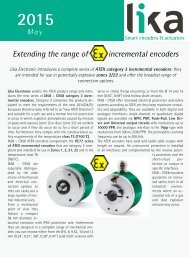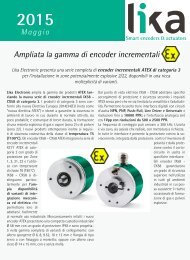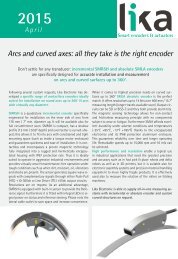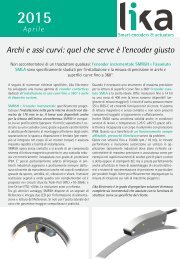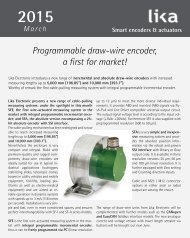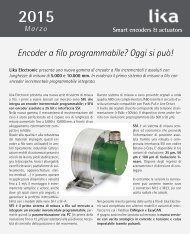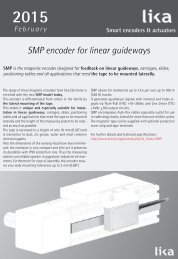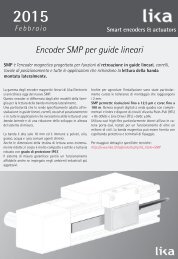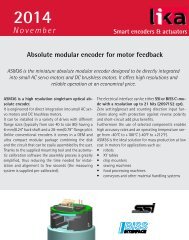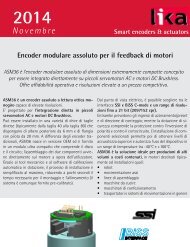LINEPULS & LINECOD catalogue 2016 in English
Lika Electronic incremental and absolute linear encoders catalogue 2016 in English Our new linear encoders catalogue is out now, and features many innovative new products and up-to-date information. The catalogue is expressly designed to set out the comprehensive range of incremental & absolute linear encoders from Lika Electronic. Check it out, it is completely renewed! Make sure you don’t miss out on a copy, download the pdf file from our web site or request your hard copy now! We have also got an interactive digital version in the works that shall be released soon!
Lika Electronic incremental and absolute linear encoders catalogue 2016 in English
Our new linear encoders catalogue is out now, and features many innovative new products and up-to-date information. The catalogue is expressly designed to set out the comprehensive range of incremental & absolute linear encoders from Lika Electronic. Check it out, it is completely renewed!
Make sure you don’t miss out on a copy, download the pdf file from our web site or request your hard copy now!
We have also got an interactive digital version in the works that shall be released soon!
You also want an ePaper? Increase the reach of your titles
YUMPU automatically turns print PDFs into web optimized ePapers that Google loves.
<strong>LINECOD</strong><br />
Output circuits and fieldbus <strong>in</strong>terfaces<br />
EtherCAT (Ethernet for Control Automation Technology) is an open Ethernet-based<br />
fieldbus system which applies Ethernet features to fieldbus technology.<br />
Its development and adm<strong>in</strong>istrative management are entrusted to the EtherCAT Technology<br />
Group (ETG) (www.ethercat.org). EtherCAT bus is simply a s<strong>in</strong>gle large Ethernet “device”<br />
which receives and sends Ethernet telegrams (standard Ethernet dataframes <strong>in</strong> accordance<br />
with IEEE 802.3).<br />
However, the “device” does not conta<strong>in</strong> an Ethernet controller, but one Master and some<br />
Slaves. Moreover any control with a commercially available Ethernet controller should be<br />
able to be used as an EtherCAT Master: standard structural components such as Ethernet<br />
switches <strong>in</strong> fact should be usable for EtherCAT. Telegrams are processed directly “on the fly”.<br />
While the telegrams (delayed by only a few bits) are already passed on, the Slave recognizes<br />
relevant commands and executes them accord<strong>in</strong>gly. Process<strong>in</strong>g is done with<strong>in</strong> the hardware<br />
and is therefore <strong>in</strong>dependent of the response times of any microprocessors that may be<br />
connected. Flexible topology variants arbitrarily extendable namely L<strong>in</strong>e, Star, Tree, Daisy<br />
Cha<strong>in</strong> + Drop L<strong>in</strong>es are possible, even <strong>in</strong> the same network. Slave configuration can be done<br />
both via XML configuration file (EtherCAT Slave Information ESI) provided by the device<br />
manufacturer and by load<strong>in</strong>g data directly from EEPROM (Slave Information Interface SII).<br />
The number of devices which can be <strong>in</strong>stalled <strong>in</strong> the EtherCAT network is virtually unlimited,<br />
while up to 65,535 nodes can be connected for each segment.<br />
The transmission rate is 100 Mbit/s with full-duplex communication (Fast Ethernet).<br />
Lika encoders with EtherCAT <strong>in</strong>terface are Slave devices and support the CANopen Over<br />
EtherCAT (CoE) protocol for data transfer; <strong>in</strong> particular they comply with the “Device Profile<br />
for encoders” Class 2 established <strong>in</strong> the “CIA Draft Standard 301” and the “CIA Draft Standard<br />
406” publications for CANopen; furthermore they comply with the EtherCAT standard<br />
established <strong>in</strong> ETG.1000 protocol conformance. As CANopen communication protocol, also<br />
EtherCAT uses PDOs and SDOs. PDO (Process Data Object) messages are used to process real<br />
time data (transmission of process data <strong>in</strong> real time, bus cycle time of 62 μs only, the faster<br />
<strong>in</strong> the market); while SDO (Service Data Object) messages are used to set and read values<br />
from the “Object dictionary” of the remote device. The follow<strong>in</strong>g transmission modes are<br />
available: FreeRun: asynchronous mode, encoder position is sampled directly from EtherCAT<br />
frame sent by the Master; position update is performed by an <strong>in</strong>ternal timer of the controller<br />
every 100 microseconds; Synchronous with SM3: data is sampled and then copied <strong>in</strong>to Sync<br />
Manager buffer as soon as the previous data are read by the Master (SM event); <strong>in</strong> this way<br />
new sampled data is synchronous with Master read<strong>in</strong>gs; Synchronous with DC: data is sampled<br />
and then copied <strong>in</strong>to Sync Manager buffer simultaneously at SYNC0 event generated<br />
by the ESC capture/compare unit. Furthermore, Lika devices support the ESM (EtherCAT State<br />
Mach<strong>in</strong>e) with Init state, Pre-operational state, Safe-Operational state and Operational<br />
state; they also implement the FOE (File Access over EtherCAT) protocol for firmware update.<br />
Among the parameters available: position readout, count<strong>in</strong>g direction, scal<strong>in</strong>g function, preset<br />
and offset values, errors register and diagnostic <strong>in</strong>formation.<br />
They are fitted with diagnostic LEDs and do not need any bus term<strong>in</strong>ation resistance.<br />
EtherCAT at a glance<br />
Number of<br />
stations<br />
Sett<strong>in</strong>g the<br />
nodes<br />
Sett<strong>in</strong>g the<br />
baud rate<br />
Transmission<br />
rate<br />
Cable<br />
length<br />
Cable<br />
Virtually<br />
unlimited<br />
Software,<br />
automatic<br />
-<br />
100 Mbit/s<br />
full duplex<br />
Up to 100 m<br />
/ 330 ft<br />
Standard<br />
EtherCAT /<br />
M12 connectors<br />
48




